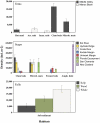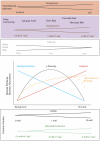Comparative composition, diversity and trophic ecology of sediment macrofauna at vents, seeps and organic falls
- PMID: 22496753
- PMCID: PMC3319539
- DOI: 10.1371/journal.pone.0033515
Comparative composition, diversity and trophic ecology of sediment macrofauna at vents, seeps and organic falls
Abstract
Sediments associated with hydrothermal venting, methane seepage and large organic falls such as whale, wood and plant detritus create deep-sea networks of soft-sediment habitats fueled, at least in part, by the oxidation of reduced chemicals. Biological studies at deep-sea vents, seeps and organic falls have looked at macrofaunal taxa, but there has yet to be a systematic comparison of the community-level attributes of sediment macrobenthos in various reducing ecosystems. Here we review key similarities and differences in the sediment-dwelling assemblages of each system with the goals of (1) generating a predictive framework for the exploration and study of newly identified reducing habitats, and (2) identifying taxa and communities that overlap across ecosystems. We show that deep-sea seep, vent and organic-fall sediments are highly heterogeneous. They sustain different geochemical and microbial processes that are reflected in a complex mosaic of habitats inhabited by a mixture of specialist (heterotrophic and symbiont-associated) and background fauna. Community-level comparisons reveal that vent, seep and organic-fall macrofauna are very distinct in terms of composition at the family level, although they share many dominant taxa among these highly sulphidic habitats. Stress gradients are good predictors of macrofaunal diversity at some sites, but habitat heterogeneity and facilitation often modify community structure. The biogeochemical differences across ecosystems and within habitats result in wide differences in organic utilization (i.e., food sources) and in the prevalence of chemosynthesis-derived nutrition. In the Pacific, vents, seeps and organic-falls exhibit distinct macrofaunal assemblages at broad-scales contributing to ß diversity. This has important implications for the conservation of reducing ecosystems, which face growing threats from human activities.
Conflict of interest statement
Figures







References
-
- Somero GN, Childress JJ, Anderson AE. Transport, metabolism, and detoxification of hydrogen sulfide in animlas from sulfide-rich marine environments. CRC Crit Rev Aquat Sci. 1989;1:591–614.
-
- Bagarinao T. Sulfide as an environmental factor and toxicant: tolrrance and adaptation in aquatic organisms. Aquatic Toxicology. 1992;24:21–62.
-
- Smith CR, De Leo FC, Bernardino AF, Sweetman AK, Arbizu PM. Abyssal food limitation, ecosystem structure and climate change. Trends in ecology and evolution. 2008;23:518–528. - PubMed
-
- Levin LA, Sibuet M. Understanding Continental Margin Biodiversity: A New Imperative. Annual Review of Marine Science. 2012;4:1–34. - PubMed
Publication types
MeSH terms
Substances
LinkOut - more resources
Full Text Sources

